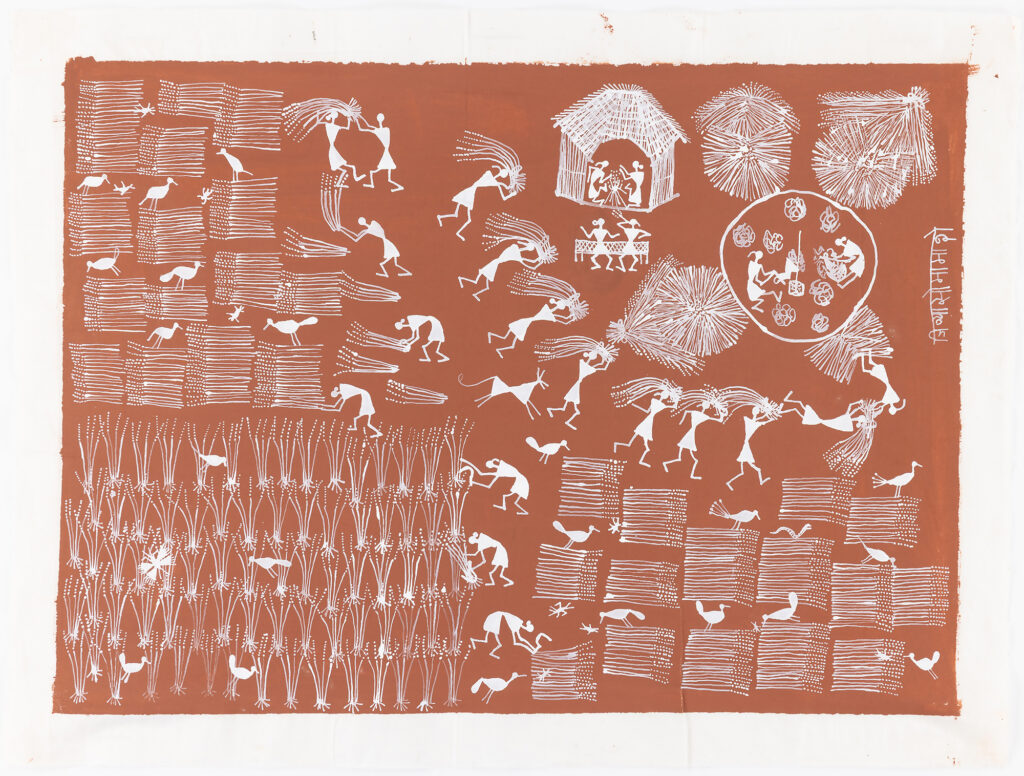Back in 1981, in an undergraduate class at UW–Madison, Mark Moilanen helped curate an exhibition of groundbreaking artworks owned by Alexander and Henrietta Hollaender. The experience, and meeting the noted UW–Madison scientist and his wife at the exhibition’s opening, was inspiring to the self-described “city kid from the streets of Milwaukee.”
The Hollaenders later went on to leave more than 250 artworks, many from the CoBrA group of Modernist artists, to the Elvehjem Museum of Art (now the Chazen).
“Ever since my schooling, I dreamed I would someday be in a position to do something like that,” said Moilanen, who went on to earn his bachelor’s, master’s, and doctoral degrees at UW–Madison.
That day has arrived. The retired art education professor has donated a painting by Indian artist Jivya Soma Mashe to the Chazen. Mashe, who died in 2018, was an important artist who is credited with bringing the Warli tribal art form to global awareness.

Jivya Soma Mashe (Indian, 1934–2018), Untitled, ca. 2006, pigment and paint on cloth, 15 x 21 1/2 in., gift of Dr. Mark Moilanen, (University of Wisconsin–Madison, B.S., 1981; M.A., 1982; Ph.D. 1989), 2025.10.
Traditionally, Warli art was done by women. They painted symbolic, geometric designs on the reddish-brown clay walls of their huts with a white paste made from rice flour, documenting important events like harvests, weddings, and festivals as a ritual practice.
Mashe was born in 1934 in a coastal village in the west central Indian state of Maharashtra. It’s said that he lost his mother at age seven and became speechless, drawing figures in the dirt to communicate and refining his skills over the years. He recovered his speech and took up traditional painting as an artistic practice, eventually moving to acrylic paint as a medium. As an adult, he was discovered by Indian government officials looking to preserve traditional art forms. As his fame grew, he exhibited internationally, was praised by Indian prime ministers, and received a state funeral when he died.
Chazen Chief Curator Katherine Alcauskas said the Mashe painting will help bolster the museum’s holdings of South Asian artwork. “Our collection of Indian miniature painting is already a point of pride, but this gift introduces to the collection a vibrant painting tradition historically rooted in the region,” she said.
In 2006, the first US exhibition of Mashe’s art was held at Shippensburg University of Pennsylvania, where Moilanen was director of K-12 art education. For the exhibition, Moilanen produced a K-12 lesson plan on Warli art and distributed it to all the state’s schools. Part of the lesson plan encouraged teachers to send their students’ work to Moilanen, who then arranged their pieces in a huge spiral in the campus gallery, echoing an important symbol in Warli art. “It was wonderful!” he said.
Moilanen acquired a piece by Mashe, had it framed, and hung it on the wall in his home. Over time, though, he thought about the lessons learned in that museum training and connoisseurship class. “It made me appreciate the idea of not keeping art to oneself, but trying to have it reach its broadest audience possible,” he said. “To hold this great art piece solely for my own eyes, in my own apartment, is wrong.”
Moilanen says he’s just glad his career path allowed him to follow the Hollaenders’ example in some way. “Today, to have that happen, makes me very happy and extremely proud.”